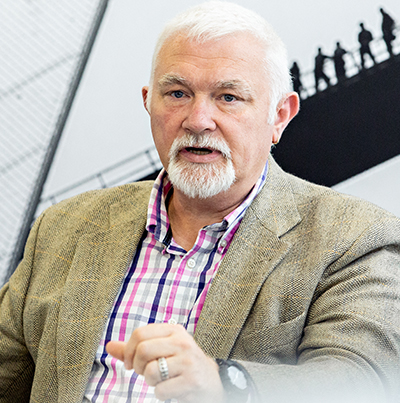At the last in our series of roundtable discussions run by the Centre for Digital Built Britain in association with Chartered Institute of Building, we brought together asset and facilities owners and managers to share their insights and consider the progress being made towards BIM as “business as usual”.
The benefits of BIM for managing risk, improving operational efficiency and asset performance were clear to all the participants. However, implementation is proving something of a challenge for the FM community.
One of the principal barriers they face is a lack of involvement at the design and build phases, which means that information to operate the buildings is not being properly specified or captured. A change of mindset – from reactive maintenance to proactive asset management – is also needed, as well as a clear articulation of the benefits of BIM throughout the whole asset lifecycle.
These were some of the topics discussed by a group of asset and facilities managers who had gathered for the eighth in our series of digital debates organised by the Centre for Digital Built Britain (CDBB) and the Chartered Institute of Building (CIOB). CDBB will use these sessions, which have also covered academia and training, constructors, consultants, manufacturers, SMEs, technology companies and specialist BIM consultants, to help understand how BIM is being adopted and to inform future work.
CDBB’s Terry Stocks and Fiona Moore were in the chair. Moore started proceedings with a broad question: “Are FM communities convinced of the potential of BIM?”
Mark Eggleton, asset information management consultant at BakerHicks, said: “FM has largely been about reactive maintenance, but the focus is increasingly on trying to be proactive in the way assets are maintained. Large estates such as airports, defence organisations and nuclear sites are already a lot more savvy about this because it’s critical to them, but for office buildings not so much.”

Roudtable participants

Standing (l-r): Stuart Young, COMIT Projects; Mark Eggleton, BakerHicks; Terry Stocks, CDBB; Steve Owen FM180; Ashley Hemmings, Sodexo; Andy Smith, John Lewis Partnership; Catriona Cantwell, Landsec. Seated (l-r): Ricardo Codinhoto, University of Bath; Fiona Moore, CDBB; Jamie Mills, Xylem Water Systems; Nicola Pearson, CDBB; Hadeel Saadoon, Coventry University Estates

Catriona Cantwell, senior project manager at Landsec, which operates in the commercial and retail sector, agreed that those types of organisations are more advanced in their approaches, but emphasised that her firm had also “started to explore the benefits of BIM through the operational phase which, after all, is going to be 30 or 40 years and where most of the value is going to come.”
In answer to Stocks’ question as to whether, post-Grenfell, there is a greater understanding of the importance of data, Cantwell agreed: “It’s hugely important. If we are leasing out buildings to different tenants, you need an asset resister that is maintained throughout the life of the building.”
Andy Smith, senior manager, head office facilities at the John Lewis Partnership, is also convinced of the benefits of BIM and is overcoming significant hurdles to realise them: “I’ve just digitised 12 floors of our head office through a combination of scanning and legacy data… We are now looking for value statements and seeing where it’s saving us money.”
Closing the information loop
The participants agreed that getting the right information handed over from the design-and-build phases is a major challenge for the FM community.
Stocks asked if any of them were involved in developing the Organisational Information Requirements (OIR) and helping to define Asset Information Requirements (AIR). Smith said he is now “because we are owning the information and the process. It’s so important to be involved at the start. You only get the benefits of… being able to see all the pipes and cables above the ceiling if you specify that you need that data. We’ve got to show people how it can make things better.”
Cantwell concurred: “FMs need to be involved in setting up the information requirements. If you don’t get the information in the right formats, it’s useless.”

Catriona Cantwell, Landsec: “Data extremely important“
Jamie Mills, chair of BIM4Water and systems engineer at Xylem Water Solutions UK and Ireland, explained that the water industry has also made good progress in recent years. “We’ve got a standard mechanism for exchanging product data and an agreed process between 20 of the UK water companies. A water company will specify what data they want and then push its supply chain for it.”
However, Steve Owen, managing director at FM180, issued a reality check: “Although some people are in a position to drive the process, most FM organisations won’t even get to see an OIR, let alone be involved in specifying it.”
Appointing a “soft landings” champion to get the operational teams involved earlier is an approach taken by Coventry University Estates. Hadeel Saadoon, BIM information manager, said: “We brought in a soft landings champion about a year ago and we are now communicating better. We started conversations between the operations team and the [building] development team and they are collaborating in developing our asset information requirements.”
Skills in FM
A recurring issue was the shortage of skills in the FM community. According to Smith: “There are not many people with the technical know-how, for example, to understand the benefits of taking a Revit file and extracting useable data from it.”
Stocks asked about the importance of having an information manager to protect the quality of the data. Owen pointed out that for large corporates or government bodies, “it’s quite easy to employ someone in that management role. It is harder for smaller companies, but we need to get to the point where we are writing into contracts that there must be someone with that skill set.”
While no-one disagreed with the principle, it can prove difficult in practice when, as Ashley Hemmings, head of asset management systems and standards at Sodexo, pointed out: “The FM contractor is brought in almost as an afterthought maybe three or four months before handover and there’s no budget for someone to sit in on design meetings at the start.”

Steve Owen, FM180: Teams need joint curriculum
He also suggested that a change of mindset is as important as acquiring new skills and capabilities: “We need to move from ‘estates management’ towards ‘asset management’. Estates management is painting a wall that needs painting. Asset management is understanding cause and effect.”
Moore asked what needs to be done in terms of education to bring about these changes.
For Owen, there is a need to: “… focus on educating people on either side of the divide – the capital and the operations teams. They need a joint curriculum.”
This has come up in previous roundtables, Stocks explained. “University education programmes tend to reflect the professional bodies requirements and there is not yet much emphasis on collaborative working to deliver a coherent outcome.”
The role of the client
There was much discussion around the key role played by the client. According to Smith: “The culture has to come from the client. They don’t need to know about asset information models but they do need to know where they can get that expertise and that a BIM-enabled environment will save them time and money.”
But for Cantwell being a client is not always straightforward. “We have asked FM providers what they need and the response has been ‘what can we have?’. That’s difficult because we don’t necessarily know.”
The challenge of integration
Another challenge faced by organisations is their inability to integrate a BIM dataset with existing FM systems. This means they may have to run multiple systems, with the increased cost and risk of inconsistency that that implies. At the University of Bath, for example, associate professor Ricardo Codinhoto explained: “At the moment we operate two separate systems, one uses BIM and the other doesn’t. Our experience is that you can’t integrate them.”
Eggleton responded that it is possible to solve this problem if the integration is “planned and you have a common language approach. But it’s tricky when 99% of what you are managing is existing estate and only 1% is new build.”
In response to Stocks’ question on whether standard templates would be helpful for the FM community, Hemmings replied: “It would be great if we could give some leadership to building a complete asset taxonomy which everybody, including designers, had to use so we had an end-to-end process in terms of data standardisation.”
However, Moore made the distinction between having a standard taxonomy for identifying assets and having standard templates that set out the core datasets clients and FM providers should be asking for. The distinction was accepted and both propositions welcomed.
Involving the supply chain
Codinhoto suggested that further benefits could be gained if the supply chain was more joined up, particularly involving manufacturers. This chimed with discussions at the manufacturers’ roundtable – they saw BIM as a way of helping the rest of the supply chain understand the importance of information and their role in supplying it.
However, Moore pointed to some of the challenges of procurement, and that “the choice of components changes during the process”. It was agreed that design for manufacture and assembly will help to resolve some of these issues
There was also discussion around the role of contracts and if FM could insist on the handover of a complete information model prior to payment, with Eggleton suggesting: “The certificate of completion gets issued after the physical completion of the build. Why not have the same for information?” It was agreed, however, that this would be difficult to enforce and operational pressures would often prevail.
Overall, participants felt that BIM is delivering real benefits to those who are adopting it and that it has a crucial role to play in managing risk and delivering significant efficiencies and better customer service. However, before it becomes business as usual, there is more work to be done in explaining the benefits and in collaborating with other functional specialists and the supply chain to obtain and maintain the right information – and be able to use it proactively.
What are you doing to both identify and realise the benefits of BIM and what is still needed to help you make BIM business as usual?
Hadeel Saadoon, Coventry University Estates – “We started by specifying our information requirements and we are now digitising our estate, getting the right space information so that we can link it to the right asset information. The next step is to try to house all our information in a common data environment and integrate it with our existing systems. We need to benchmark where we are and measure how we’re going to benefit from it.”
Catriona Cantwell, Landsec – “We have developed a very detailed set of EIRs, working with different stakeholders – our operations, security, sustainability and finance teams – to find out what they would want from a BIM model, whether we were to sell the building or to operate it. The rationale for doing this is that our buildings cost less, they’re quicker to build, and they run more efficiently. We also manage our estate and also it allows us to monitor our buildings and greatly reduce our risk.”

Hadeel Saadoon: “We brought in a soft landings champion”
Andy Smith, John Lewis Partnership – “Clients have a pivotal role to play and we will provide leadership in this space. We will record the benefits to demonstrate value.”
One of our challenges is that there is a plethora of platforms out there, none of which do everything. The ability to move data around more easily and minimise the requirement on the client to carry all the data would be helpful.
Ashley Hemmings, Sodexo – “In FM, we need information on everything: carpets, tables, chairs, TVs, ceilings. The key for us is to start with an asset management model. That model then should form the basis of the OIR.”
You then have an idea of the critical assets before you build the building. We want product templates to work. LEXiCON is one of the tools that could really help, making sure that everyone uses the same taxonomy of asset types.
Steve Owen, FM180 – We try to, as it says in all the guidance, start with the end in mind. We need to understand what the operate and maintain phase needs from BIM in terms of information and data. We are trying to do that by running pilot projects to collect data and show the benefits of BIM, because although there has been a lot of early adopter work, there is very little AEC through to FM evidence out there. The other gap is education, and that’s on both sides of the fence.
Jamie Mills, Xylem Water Solutions – As a [water] industry we’re realising the true value of good information management and operation. This will lead to better business decisions, better operation of assets and better return on investment. The majority of the benefits to date have been in capital delivery. However, this is now shifting into operational and performance measures and ultimately to customer service. Water companies are now beginning to define their information requirements and make the delivery of asset data a contractual requirement.
Ricardo Codinhoto, University of Bath – Once the targets for FM become clearer in terms of the contribution it makes to the business, you will get support from above to implement it. We need a better understanding of the impact of a single point of failure in a business. If you understand that, then you understand that your business might be at risk.
You also need a driver of change at a national level. In the Netherlands, for example, the sustainability agenda is driving BIM. In the UK, the Hackitt inquiry could play a similar role.
Mark Eggleton, BakerHicks – We are developing a configuration management approach. We identify the information we need in order to mitigate or reduce operational risk. Our focus is on making sure we have accurate, relevant and timely information which is easy for people to find and have confidence in.
The industry needs to understand the value of accurate and complete information across all parties – and the cost of not having it. How much are you spending on resurveying, reprocuring information? It’s all about reducing risk from a design, contractor and operational point of view.
Stuart Young, COMIT Projects – The client lead role is, for me, the most important. It’s also vital that we benchmark as we go forward. Some clients still need convincing about BIM. Case studies are imperative.
Getting the client to insist that FM teams are involved earlier is key. The other big problem is the supply chain. There are lots of people we really need to engage in the process, but they’re further down the line, the Tier 2s, Tier 3s and beyond. Some of them are one- or two-man operations. I keep hearing them say: “We don’t have time for BIM. How are we going to get involved?” Addressing that problem could have a huge impact on delivering BIM and its benefits.
Key takeaways
- BIM has a critical role to play in managing risk in a post-Grenfell world, as well as delivering operational efficiencies and better customer service.
- The FM community needs to be involved in specifying information requirements from the start of a build.
- Asset and Facilities Management needs to switch from reactive maintenance to proactive asset management for the benefits of BIM to be maximised.
- Adopting BIM will also help delivery of the “golden data” thread that maintains key asset data across the lifecycle.
- The teams involved in the capital and operational phases need to have a better understanding of each other’s roles and to develop a common language. Specified data requirements need to reflect the different stakeholder/professional services “lenses”.
- The whole supply chain, including manufacturers, need to work together more effectively and use a standard taxonomy for describing assets.
- Standard templates containing core datasets could help clients and FM providers who are not fully conversant with their data requirements start to reap the benefits.
- More case studies are needed to demonstrate the value of a BIM-enabled approach to clients.
- The sector’s professional bodies and the UK’s educational institutions need to come together to support a more collaborative way of working.
Join us in Cambridge for a BIM Roundtable Reception
As part of CDDB Week, CDBB and the Construction Innovation Hub will be hosting a garden party on Wednesday 11 September for everyone involved with and interested in the Roundtable series. We will share a summary of findings from the Roundtables series and the next steps for CDBB and the Construction Innovation Hub in supporting BIM to become ‘business as usual’. Please see the CDDB website for details and to register to attend: www.cdbb.cam.ac.uk.
Comments
Comments are closed.














This is really insightful. Well done. Bring on the case studies please.